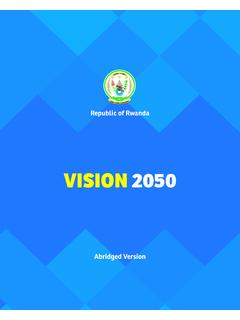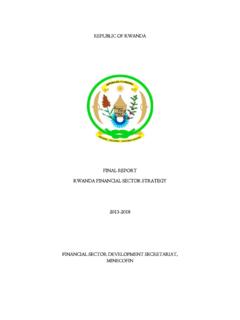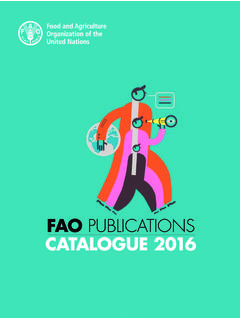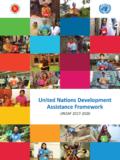Transcription of MINISTRY OF NATURAL RESOURCES
1 1 REPUBLIC OF RWANDA MINISTRY OF NATURAL RESOURCES FIVE YEAR STRATEGIC PLAN FOR THE ENVIRONMENT AND NATURAL RESOURCES SECTOR - 2014 2018 September 2013 2 Acronyms AfDB : African Development Bank ALPFG : Africa Land Policy Framework and Guidelines BCC : Budget Circular Call CBOs : Community Baed Organisations CPAF : Common Performance Assessment Framework CSOs : Civil Society Organisations DDPs : District Development Plans DFID : Department for International Development EAC : East African Community EDPRS : Economic Development and Poverty Reduction Strategy EESD : Environmental Education for Sustainable Development EIA : Environmental Impact Assessment EICV : Integrated Household Living Conditions Survey ENR : Environment and NATURAL RESOURCES FONERWA : National Climate and Environment Fund GDP : Gross Domestic Product GIS : Geographic Information System IDP : Internally Displaced Persons IWRM : Integrated Water resource Management LAIS : Land Admnistration Information System LTRSS : Land Tenure Regularisation Support System M&E : Monitoring and Evaluation MINAGRI : MINISTRY of Agriculture and Animal RESOURCES MINALOC : MINISTRY of Local Government MINECOFIN.
2 MINISTRY of Finance and Economic Planning MINEDUC : MINISTRY of Education MININFRA : MINISTRY of Infrastructure MINIRENA : MINISTRY of NATURAL RESOURCES MoH : MINISTRY of Health NAPA : National Adaptation Programme of Action NBI : Nile Basin Initiative NFC : New Forests Company NGOs : Non-governmental Organisations NLUDMP : National Land Use and Development Master Plan PAIGELAC : Inland Lakes Intergrated Development and Management Support Project PEER : Public Environmental Expenditure Review PNLP : National Malaria Control Programme PSTA : Agricultural Sector Investment Plan RDB : Rwanda Development Board REMA : Rwanda Environment Management Authority RNRA : Rwanda NATURAL RESOURCES Authority RSSP : Rural Sector Support Project SEI : Stockholm Environment Institute SEA : Strategic Environmental Assessment SIDA : Swedish International Development Agency SMEs : Small and Medium Enterprises SOER : State of Environmental Report TIG : Community Service for Prisoners 3 Table of content Acronyms.
3 2 Table of content .. 3 Executive Summary .. 5 Environment and NATURAL RESOURCES sector Priorities and Innovations .. 5 5. Environment and NATURAL RESOURCES Sector Monitoring and Evaluation .. 8 1. Introduction .. 9 Context .. 9 The Methodology .. 10 2. Overview of the Environment and NATURAL RESOURCES Sector .. 11 Policy Context .. 11 National Policies and strategies .. 11 Environment and NATURAL RESOURCES Sector Policies .. 14 Key Cross-sector and Regional Policy Implications .. 16 Other ENR Sector Strategic Documents .. 19 Sector Status, Achievements and Challenges .. 21 ENR Sector Status and Achievements .. 21 Challenges in Environment and NATURAL RESOURCES .
4 28 Institutional Overview of the Sector .. 29 3. Environment and NATURAL RESOURCES strategic framework .. 31 Mission and Objectives of the ENR 31 Results chain .. 32 Contribution of Environment and NATURAL RESOURCES sector to EDPRS II .. 34 Environment and NATURAL RESOURCES sector Priorities and Innovations .. 34 ENR Strategic areas for District Development Plans (DDPs) .. 36 Conribution to EDPRS 2 Thematic area .. 37 Cross cutting issues mainstreaming .. 44 Capacity building .. 44 Gender and family promotion .. 45 Environment, Climate change and disaster management:.. 46 HIV/AIDS and non-communicable diseases.
5 47 Social inclusion and disability .. 47 Regional integration .. 48 4. Implementation of the ENR Sector Strategic Plan .. 49 Background .. 49 Roles and responsibilities of the TWGs members .. 50 Central Government .. 50 The Local Government .. 53 The Private sector .. 54 4 Financial institutions and Development partners .. 56 The Media .. 58 5. Environment and NATURAL RESOURCES Sector Monitoring and Evaluation .. 58 ENR M&E development guiding principles and approach .. 58 ENR M&E: Focusing results on Sustainability .. 58 Objective of ENR Monitoring and Evaluation framework .. 59 The step wise approach to successful ENR M&E.
6 59 Reporting for EDPRS 2 .. 60 6. Budget, Financing and Financial Management .. 70 Cost structure and costing of Planned Activities .. 70 Strategic Plan Financing Mechanisms .. 72 resource Allocation and Financial Management Arrangements .. 72 ANNEXES .. 73 5 Executive Summary Contextual background This strategy which will cover a five year period (2013 2018) is developed to implement the second phase of the Economic Development and Poverty Reduction Strategy with the aim of achieving the revised targets of vision 2020. In line with the Vision 2020 objective of transforming Rwanda into a middle income country by 2020, the overall objective of EDPRSII is to increase the quality of life of all Rwandans through rapid and sustainable economic growth ( per annum) and accelerated poverty reduction (to below 30%).
7 To meet these objectives, EDPRSII is developed around four strategic thematic areas (Economic Transformation, Rural Development, Productivity and Youth Employment, and Accountable Governance), which will drive rapid and sustainable economic growth, as well as fast reduction of poverty country wide. EDPRSII will be implemented through a set of Sector and District Strategies, which will be fully aligned to the priorities and themes of EDPRSII. The Environment and NATURAL RESOURCES (ENR) Sector and District strategies will contribute to the achievement of the four thematic areas and will mainstream key cross-cutting issues which the EDPRS II identified as Environment and Climate change, Gender and Family promotion, HIV/AIDS, Capacity building, Regional integration, Social inclusion and disability and Disaster management.
8 Environment and NATURAL RESOURCES strategic framework The Objective of this strategy is to ensure that environment and NATURAL RESOURCES are utilized and managed productively in support of equitable and sustained national development and poverty reduction. This will be realized in 5 specific objectives : (1) To increase and sustainably manage ecosystems and forest RESOURCES to optimize their economic as well as ecological functions; (2) To put in place and operationalise an efficient system of land administration and land management that secure land ownership, promote investment in land for socio-economic development and poverty reduction.
9 (3) To ensure that development in Rwanda is undertaken in a manner that inflicts minimal damage to the environment, and building resilience to threats posed by climate change for the sustained support to economic, social and cultural development of Rwanda. (4) To secure and provide water of adequate quantity and quality for all social and economic needs of the present and future generations with the full participation of all stakeholders in decisions affecting its management; (5) To improve the Geology and Mines sub-sector to contribute optimally and sustainably to the national income and to the social economic welfare of the community.
10 Environment and NATURAL RESOURCES sector Priorities and Innovations ENR Sector Priorities and new Innovations will focus mainly on supporting key thematic areas identified in EDPRS 2 related to economic transformation, rural development, productivity and youth employment, and effective governance. 6 The contribution of forestry RESOURCES to economic growth and poverty reduction will be attained by the increase of forest cover across the nation as well as the increase and sustainable management of ecosystems and forestry RESOURCES . The Rwanda s EDPRS II 2013-2018 retains forestry as a main concern in recognition of its prime contribution to the GDP.






